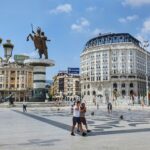Imagine if you woke up this morning from a nightmare that there had been two Hiroshima-sized nuclear explosions within eyesight of your home every single day for the last 35 years. Currents of wind and water had carried radioactive material through your community and beyond, ever-increasingly contaminating the planet’s ecosystems with radiation. As you screamed in agony, trying to convince the world that an atrocity was occurring in your own backyard that was inevitably affecting them as well, most failed to recognize the consequences for decades.
Unfortunately for some, this is not a nightmare that they can ever truly wake up from. It is the reality of the atmospheric nuclear testing that the United States, Soviet Union, United Kingdom, France, and China produced in open-air settings across the globe. When the United States performed the first ‘Trinity’ nuclear weapons test seventy-five years ago on 16 July 1945, it opened the door to the 2,000-plus nuclear tests that followed. Around a quarter of these tests were atmospheric in nature and their aggregate yield was approximately 428 megatons, or the equivalent of around 29,600 Hiroshima-sized nuclear explosions. In turn, while the Trinity test is only a scratch on the surface of the number of nuclear detonations the world has experienced, it has left the boldest scar on the planet’s health.
If we do not work together to shine a light on the shadows of powerful yet pernicious explanations as to why certain leaders are taking steps to lower the threshold of nuclear use – including through the potential re-emergence of nuclear testing – the current political moment will be lost to those who wish to never see a true end to the threat of nuclear weapons. There is simply no technical need for the United States – which has already conducted over half of the world’s nuclear tests – or any other power committed to non-proliferation and disarmament to resume testing. That such ideas are even being discussed sends harmful signals for strategic stability and arms control.
The reality is that nuclear weapons were violently thrust into the lives of many populations around the world – from the American Southwest to present-day Kiribati and Kazakhstan to the Xinjiang Province – as major powers attempted to relegate their experiments to the peripheries and margins of their territories.
As the world marks the 75th anniversary of the US bombings of Hiroshima and Nagasaki – the only time that nuclear weapons were used in conflict – we must also remember the violent processes involved in creating and testing those weapons. In fact, estimates suggest that more Americans died as a result of nuclear testing than those killed during the aforementioned attacks. While infamous iconography of the atomic mushroom cloud is often associated with the catastrophic suffering in Hiroshima and Nagasaki, the perils experienced by various communities around the world due to atmospheric nuclear testing are ironically not discussed through the prism of “nuclear warfare,” despite feeling like exactly that for many people. Although much larger in scale, nuclear use through testing does not ontologically register in the same ways, and in some cases, does not register at all.
In order to meaningfully reflect upon the 75th anniversary of the dawn of the nuclear age, we must acknowledge that it is not only war that causes harm, but also the preparation for it. Whether the health consequences experienced by uranium mine workers inhaling radon gas as far away as the Congo or the many communities displaced and debilitated by the processing and testing of the nuclear weapons that were produced as a result, the generational suffering accompanying the entire life cycle of nuclear weapons has been erased from our collective consciousness. As the Doomsday Clock ticks, the sci-fi-esque perception of impending nuclear Armageddon continues to eclipse the tragedies associated with the repetitive atmospheric nuclear explosions that were carried out by world powers. The many people who had no choice but to confront the fallout of nuclear use are not waiting for the end of the world, for their worlds have already ended many times over.
There is often an assumption made today that the term “nuclear weapons” is easily and fully translatable across cultures by virtue of generality. However, this is wholly dependent on another assumption, which is that there is a conceptual equivalency of these weapons between languages. The reality is that nuclear weapons were violently thrust into the lives of many populations around the world – from the American Southwest to present-day Kiribati and Kazakhstan to the Xinjiang Province – as major powers attempted to relegate their experiments to the peripheries and margins of their territories. For these populations, there was no language for “nuclear weapons” or the unique consequences they bore, and in turn, the scale of feeling behind the vocabulary that was created to describe them is more aligned with their true nature. We look to the biographical memory of these victims and their descendants – who carry forward the legacy of testing in their DNA – to inspire our advocacy because their understandings of nuclear weapons are far different from how the majority of the world abstractly sees and speaks about them.
Just like the ants who carry small pieces of ‘Trinitite’ – or molten glass formed by grains of sand that were thrown into the air by Trinity’s nuclear fireball – to the earth’s surface, we must also exhume history in our own ways. As we continue to pick up the remnants of the Jornada del Muerto — or Dead Man’s Journey — desert where the Trinity test occurred, we must realize that the legacy of nuclear testing is much greater than can be physically seen and much wider than can be noticeably traced. Carried by high winds, it has enveloped the entire planet over time. Nuclear fallout from American and Russian nuclear tests was even found in London rainwater.
We must recollect and reassemble the historical consequences of nuclear testing, unlearning the monolingualism through which we speak about nuclear weapons and allowing a wider plurality of voices to define how the global public understands nuclear risk and consequences. By allowing the victims who faced the torture of continued nuclear use to define nuclear weapons and the realities of the power that they hold, we can restore the biographical memory needed to remind us of why we must close the door to nuclear testing once and for all. If we listen to how these communities have suffered for generations, a completely new scale of feeling can emerge that will allow us to re-define our conception of nuclear weapons and truly reckon with the lack of progress in global nonproliferation and disarmament, including the long-awaited entry-into-force of the Comprehensive Nuclear Test Ban Treaty.
After all, if a simple sneeze or cough can send particles flying up to almost 30 feet, imagine how widespread the legacy of 29,600 Hiroshima-sized nuclear explosions has been on us all.
Sahil Shah is a Policy Fellow at the European Leadership Network. He is a Founding Member and the Current Co-Chair of the CTBTO Youth Group and a former Policy and Outreach Consultant to the CTBTO Office of the Executive Secretary. The opinions articulated above represent the views of the author and do not necessarily reflect the position of the European Leadership Network or any of its members.





















